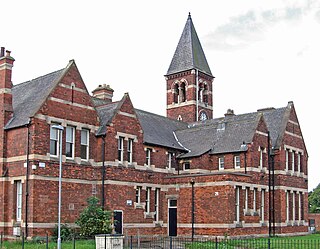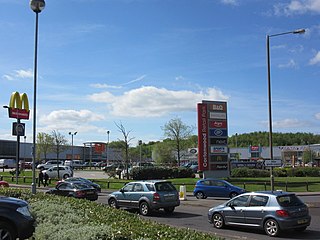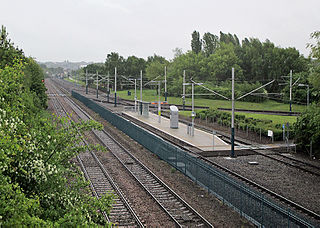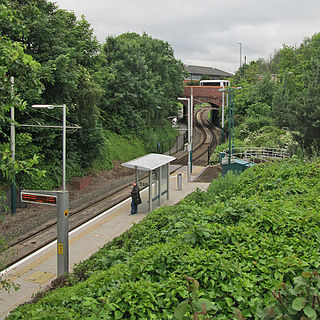
Eastwood is a former coal mining town in the Broxtowe district of Nottinghamshire, England, 8 miles (13 km) northwest of Nottingham and 10 miles (16 km) northeast of Derby on the border between Nottinghamshire and Derbyshire. Mentioned in Domesday Book, it expanded rapidly during the Industrial Revolution. The Midland Railway was formed here and it is the birthplace of D. H. Lawrence. The distinctive dialect of East Midlands English is extensively spoken, in which the name of the town is pronounced.

Nottingham Express Transit (NET) is a 32-kilometre-long (20 mi) tram system in Nottingham, England. The system opened to the public on 9 March 2004 and a second phase, that more than doubled the size of the total system, opened on 25 August 2015, having been initially planned to open two years earlier.

Croxdale is a village in the civil parish of Croxdale and Hett, situated about 3 miles (4.8 km) south of Durham City, in County Durham, England and on the A167 road, formerly part of the Great North Road. It is on the route of the East Coast Main Line and at one time had a station. The railway crosses over Croxdale Viaduct, built in 1872, just north of the village. The Weardale Way long distance footpath passes through the nearby Croxdale Hall estate.

Royal Centre is a tram stop of Nottingham Express Transit (NET) in the centre of the city of Nottingham. It derives its name from the adjacent Theatre Royal and the Royal Concert Hall. The stop is also close to the Cornerhouse, the Victoria Centre and the Newton Building of Nottingham Trent University, although much of the university's City Campus is closer to the Nottingham Trent University stop.

Bestwood Village is an area and civil parish in the Gedling district of Nottinghamshire. Until 1 April 2018 it was part of the civil parish of Bestwood St. Albans. A small part of the village falls within the Ashfield district council area. There have been several new housing estates built recently including the redevelopment of the former Bayles and Whylie factory site which was a former glue mill. It is to the east of Hucknall and north of Bulwell. It is neighboured to the north by the village of Papplewick. It is also close to the Bestwood Park Estate which is in the City of Nottingham.

Basford is a northerly suburb of Nottingham, England, incorporated into the city in 1877. It gave its name to Basford Rural District, which existed from 1894 to 1974. The ward population at the 2011 census was 16,207, estimated at 16,779 in 2019. Next to Old Basford is New Basford, which is mainly Victorian. Basford lies close to the River Leen, a tributary of the River Trent. It is linked to Nottingham City Centre to the south and Hucknall and Bulwell to the north by the Nottingham Express Transit tram service.

Temple Normanton is a village and a civil parish in the North East Derbyshire district in Derbyshire, England. The population of the civil parish at the 2011 census was 490.

Aspley is a council estate and a ward of the city of Nottingham, Nottinghamshire, England. It is located within the boundaries of Nottingham City Council. The ward is located 3 miles (4.8 km) west of Nottingham City Centre and is located only 1.6 miles west of Junction 26 of the M1. It lies south of Bulwell, west of Basford and is north of Bilborough. The principal road in the ward is the A610. At the 2001 Census the ward had a population of 15,689, increasing to 17,622 at the 2011 census.
The Erewash Valley Line is a railway line in England, running from Long Eaton, located between Nottingham and Derby, and Clay Cross, near Chesterfield. The southern part was opened by the Midland Railway in 1847 as far as Codnor Park, where it connected to established ironworks, and soon after, a line to Pinxton and Mansfield.

Cortonwood was a colliery near Rotherham, South Yorkshire, England. The colliery's proposed closure was a tipping point in the 1984-85 miners' strike. The site is now a shopping and leisure centre.

Snibston is an area and former civil parish east of Ravenstone, now in the parish of Ravenstone with Snibstone, in the North West Leicestershire district, in the county of Leicestershire, England. Originally rural, part of Snibston was transformed into a coal mining village by the opening of coal mines by the Snibston Colliery Company in the early 1830s. This industrial part of Snibston was subsequently subsumed into the developing town of Coalville, though small rural areas of Snibston survive within the civil parishes of Ravenstone with Snibston and Hugglescote and Donington le Heath. In the part of Snibston within the latter civil parish stands the 13th-century church of St Mary, noted as the smallest church still in use for regular worship in England. The main Snibston Colliery was sunk in 1831, and after its closure the Snibston Country Park with the Snibston Discovery Museum was built on part of the colliery site. Part of the park is Snibston Grange Local Nature Reserve.

Highbury Vale is a stop on the Nottingham Express Transit tram system in the city of Nottingham near the boundary between the suburbs of Basford and Bulwell. It serves as the main interchange between the Hucknall and Phoenix Park branches of the initial system - however, NET recommends that people alight at the previous stop rather than change at Highbury Vale, due to the lines splitting at Babbington junction, just before the trams reach the stop.

The A610 is an A-road in England, which runs from Nottingham to Ambergate, where it joins the A6.

David Lane is a tram station on Nottingham Express Transit, in the city of Nottingham suburb of Basford. The tram lines here run parallel to the Robin Hood railway line that links Nottingham with Worksop, but there is no corresponding railway station. Both tram and railway lines have two tracks, and the resulting four tracks cross David Lane on a pair of parallel level crossings. The tram stop comprises a pair of side platforms on both sides of the tramway.

Acland is a rural town and locality in the Toowoomba Region, Queensland, Australia. In the 2016 census the locality of Acland had a population of 32 people.
Weston Coyney is a suburb of the City of Stoke-on-Trent in Staffordshire. It lies on the south eastern edge of the city and borders the neighbouring Staffordshire Moorlands district.

Hatfield Colliery, also known as Hatfield Main Colliery, was a colliery in the South Yorkshire Coalfield, mining the High Hazel coal seam. The colliery was around 1 mile (1.6 km) northwest of Hatfield, South Yorkshire, adjacent north of the railway line from Doncaster to Scunthorpe northeast of Hatfield and Stainforth railway station.

Phoenix Park is a tram stop on the Nottingham Express Transit (NET) light rail system, in the city of Nottingham suburb of Bulwell. It serves as one of the two northern termini of the NET's initial system, and is at the end of the short single line branch from Highbury Vale. The stop has a single island platform, flanked by two stub tracks which are segregated from the adjacent road. Phoenix Park serves as one of several park and ride stops on the NET network, with more than 600 car parking spaces located next to the stop.

Cinderhill is a tram stop on the Nottingham Express Transit (NET) light rail system in the city of Nottingham on the boundary between the suburbs of Basford and Bulwell. It was part of the NET's initial system, and is situated in the middle of the short single line branch between Highbury Vale and Phoenix Park tram stops. The stop comprises a single platform and track, situated in a cutting between two bridges and served by trams running in both directions.

Cinderhill is an area in the City of Nottingham. It is located roughly 3.1 miles (5.0 km) from the City Centre, and surrounding areas include Bulwell to the north, Aspley and Broxtowe to the south, Basford to the east and Nuthall to the west.


















